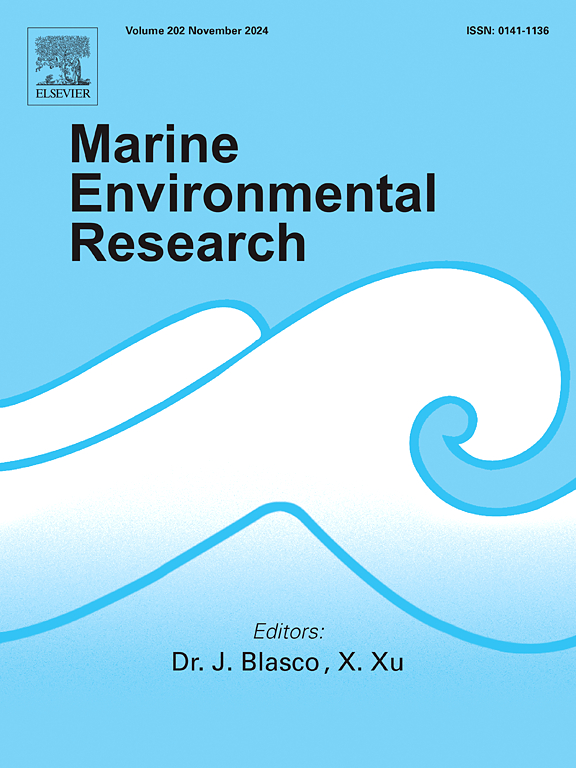Organophosphate esters and phthalate esters in marine fishes from a coastal area of China: Occurrence, tissue distribution, trophic transfer, and human exposure
IF 3
3区 环境科学与生态学
Q2 ENVIRONMENTAL SCIENCES
引用次数: 0
Abstract
Concern over the influences of constant addition of anthropogenic chemicals to the marine environment has attracted public attention. Organophosphate esters (OPEs) and phthalate esters (PAEs) were two emerging chemicals frequently added to a variety of products as flame retardants and plasticizers. However, limited information is available associated with their environmental behaviors in marine environment, and the tissue-specific bioaccumulation and biomagnification of OPEs and PAEs in fish remain subjects of ongoing debate. Hence, 12 OPE and 6 PA E analogues were analyzed in five marine fish species from the coast of Wenchang, Hainan province. The concentrations of Σ12OPEs and Σ6PAEs were in the range of 319–1790 ng/g lw and 400–1370 ng/g lw, respectively. Significantly negative correlations (p value < 0.05) were observed between the concentration of pollutants and their corresponding lipid contents of fish tissues. There were no obvious correlations between the logarithmic transformed concentrations of each OPE and PAE analogue with their corresponding Log KOW value in fish tissues, but OPE and PAE concentrations were likely to reach the highest when Log KOW values were around five. Significantly negative correlations (p value < 0.05) were found between logarithmic transformed concentrations of TCEP, TCP and BBP along with δ15N values in fish species, except for TDCIPP, TEHP and DBP which exhibited an increasing trend with the increasing of δ15N values. Furthermore, human exposure via fish intakes was assessed, and EDI ranged from 73.9 to 1910 ng/kg bw/day for ∑OPEs and 495–4550 ng/kg bw/day for ∑PAEs, respectively, which were both within the safe dose threshold, and the HI values of ΣOPEs and ΣPAEs were much lower than the boundary value of 1.00. This study contributes valuable insights into OPEs and PAEs present in marine organisms as well as robust evidence indicating that most OPE and PAE analogues undergo trophic dilution within marine fish.
中国沿海地区海鱼中的有机磷酸酯和邻苯二甲酸酯:发生、组织分布、营养转移和人类暴露
对不断向海洋环境添加人为化学物质的影响的关注引起了公众的注意。有机磷酸酯(OPEs)和邻苯二甲酸酯(PAEs)是两种新兴的化学品,经常作为阻燃剂和增塑剂添加到各种产品中。然而,与它们在海洋环境中的环境行为相关的信息有限,鱼类中OPEs和PAEs的组织特异性生物积累和生物放大仍然是争论的主题。为此,对海南文昌沿海5种海鱼的12种OPE和6种pae类似物进行了分析。Σ12OPEs和Σ6PAEs的浓度分别为319 ~ 1790 ng/g lw和400 ~ 1370 ng/g lw。显著负相关(p值<;污染物浓度与其对应的鱼组织脂质含量之间存在显著性差异(0.05)。鱼类组织中各OPE和PAE类似物的对数转化浓度与其对应的Log KOW值之间没有明显的相关性,但当Log KOW值在5左右时,OPE和PAE的浓度可能达到最高。显著负相关(p值<;除TDCIPP、TEHP和DBP随δ15N值的增加呈增加趋势外,鱼类中TCEP、TCP和BBP的对数转换浓度随δ15N值的增加呈增加趋势。通过鱼类摄入评估人体暴露,∑OPEs的EDI范围为73.9 ~ 1910 ng/kg bw/day,∑PAEs的EDI范围为495 ~ 4550 ng/kg bw/day,均在安全剂量阈值范围内,且HI值ΣOPEs和ΣPAEs远低于临界值1.00。该研究为海洋生物中存在的OPEs和PAEs提供了有价值的见解,并提供了强有力的证据表明,大多数OPEs和PAE类似物在海洋鱼类中经历了营养稀释。
本文章由计算机程序翻译,如有差异,请以英文原文为准。
求助全文
约1分钟内获得全文
求助全文
来源期刊

Marine environmental research
环境科学-毒理学
CiteScore
5.90
自引率
3.00%
发文量
217
审稿时长
46 days
期刊介绍:
Marine Environmental Research publishes original research papers on chemical, physical, and biological interactions in the oceans and coastal waters. The journal serves as a forum for new information on biology, chemistry, and toxicology and syntheses that advance understanding of marine environmental processes.
Submission of multidisciplinary studies is encouraged. Studies that utilize experimental approaches to clarify the roles of anthropogenic and natural causes of changes in marine ecosystems are especially welcome, as are those studies that represent new developments of a theoretical or conceptual aspect of marine science. All papers published in this journal are reviewed by qualified peers prior to acceptance and publication. Examples of topics considered to be appropriate for the journal include, but are not limited to, the following:
– The extent, persistence, and consequences of change and the recovery from such change in natural marine systems
– The biochemical, physiological, and ecological consequences of contaminants to marine organisms and ecosystems
– The biogeochemistry of naturally occurring and anthropogenic substances
– Models that describe and predict the above processes
– Monitoring studies, to the extent that their results provide new information on functional processes
– Methodological papers describing improved quantitative techniques for the marine sciences.
 求助内容:
求助内容: 应助结果提醒方式:
应助结果提醒方式:


